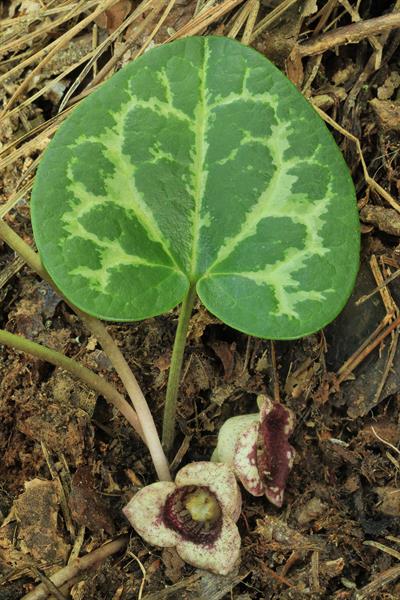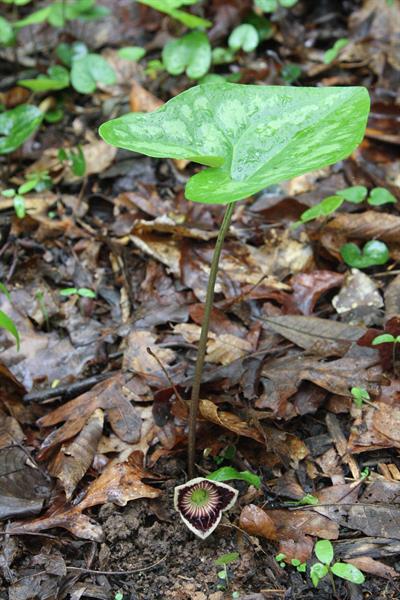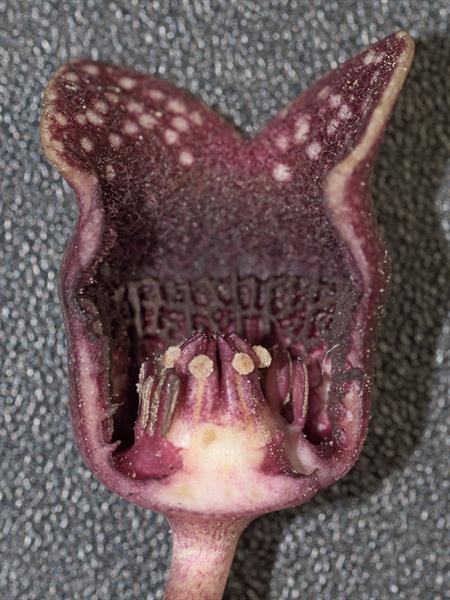
A genus of perhaps 15-20 species, herbs, of se. North America, very possibly best expanded to include Asian taxa treated in Heterotropa and Asiasarum. Barringer (1993) and Kelly (1997, 1998) have recently employed a broad definition of Asarum, including Hexastylis. Over the last half-century various students of the group (emphasizing a range of fields of evidence) have arrayed themselves for and against the recognition of Hexastylis as a genus distinct from Asarum. A cladistic analysis (Kelly 1997, 1998) showed distinctive clades which could be interpreted as evidence for the recognition of Hexastylis (including the Asian Heterotropa), though the author preferred to recognize 2 subgenera. I choose here to follow the more traditional (at least in our area) separation of Hexastylis from Asarum, until and unless stronger evidence is presented for their combination. Electrophoretic and morphologic studies currently in progress validate the species / varietal level taxonomy presented, insofar as results are available (Z. Murrell, pers. comm., 2013; R. Wyatt, pers. comm.). A difficult genus, Hexastylis is made more frustrating by the fact that nearly all diagnostic features relate to the shape and size of the fleshy and brittle calyx – characters which are difficult to describe and are largely lost when specimens are pressed. The difficulty of identifying herbarium specimens has sometimes been (apparently) used as a justification for reducing (often drastically, as in Gleason & Cronquist 1991) the number of taxa recognized. To those familiar with this genus in the field, however, the taxa here recognized form geographically distinctive populations. Size and (to a lesser degree) shape of individual flowers show considerable variation and can be altered by environmental factors; individual flowers or plants can be difficult to identify if taken out of context. Populations, however, are usually readily identifiable.
Key advice:The photograph (Figure 1) in Gaddy (1987a) of the flowers of all species then known (other than H. arifolia and H. speciosa) is highly recommended as an aid to identification. The calyx tube orifice is measured on the inside – the diameter of the opening. The width of calyx lobes is measured from sinus (notch) to sinus (notch).
Ref: Barringer (1993); Blomquist (1957); Diamond (2023); Gaddy (1986); Gaddy (1987a); Gaddy (1987b); Gaddy (2011); Gaddy In Wofford (1989); Gleason & Cronquist (1991); Huber In Kubitzki, Rohwer, & Bittrich (1993); Keener (2020); Keener & Davenport (2015); Keener & Todia (2021); Kelly (1997); Kelly (1998); Schaner (2021); Sinn (2015); Sinn (2017a); Sinn (2017b); Sinn, Kelly, & Freudenstein (2015a); Sinn, Kelly, & Freudenstein (2015b); Sugawara (1987); Weakley & Poindexter (2020a) In Weakley et al. (2020); Whittemore & Gaddy (1997) In Flora of North America Editorial Committee (1997). Show full citations.
Hover over a shape, letter, icon, or arrow on the map for definition or see the legend. Data for arrows not developed for genera and families which may have species only occurring outside the flora area.
 © Alan M. Cressler | Hexastylis heterophylla | Original Image ⭷
© Alan M. Cressler | Hexastylis heterophylla | Original Image ⭷ © Alan Cressler: Hexastylis rhombiformis, upper French Broad River drainage, Transylvania County, North Carolina 1 by Alan Cressler | Hexastylis rhombiformis source | Original Image ⭷
© Alan Cressler: Hexastylis rhombiformis, upper French Broad River drainage, Transylvania County, North Carolina 1 by Alan Cressler | Hexastylis rhombiformis source | Original Image ⭷ © Gary P. Fleming | Hexastylis arifolia | Original Image ⭷
© Gary P. Fleming | Hexastylis arifolia | Original Image ⭷ © Alan M. Cressler | Hexastylis ruthii | Original Image ⭷
© Alan M. Cressler | Hexastylis ruthii | Original Image ⭷ © Gary P. Fleming | Hexastylis heterophylla | Original Image ⭷
© Gary P. Fleming | Hexastylis heterophylla | Original Image ⭷ © Jim Fowler | Hexastylis shuttleworthii | Original Image ⭷
© Jim Fowler | Hexastylis shuttleworthii | Original Image ⭷ © Bruce A. Sorrie | Hexastylis speciosa | Original Image ⭷
© Bruce A. Sorrie | Hexastylis speciosa | Original Image ⭷ © Alan Cressler: Hexastylis finzelii, Marshall County, Alabama 1 by Alan Cressler | Hexastylis finzelii source | Original Image ⭷
© Alan Cressler: Hexastylis finzelii, Marshall County, Alabama 1 by Alan Cressler | Hexastylis finzelii source | Original Image ⭷ © Gary P. Fleming | Hexastylis heterophylla | Original Image ⭷
© Gary P. Fleming | Hexastylis heterophylla | Original Image ⭷Feedback
See something wrong or missing on about Hexastylis? Let us know here: (Please include your name and email if at all complicated so we can clarify if needed.)
Cite as...